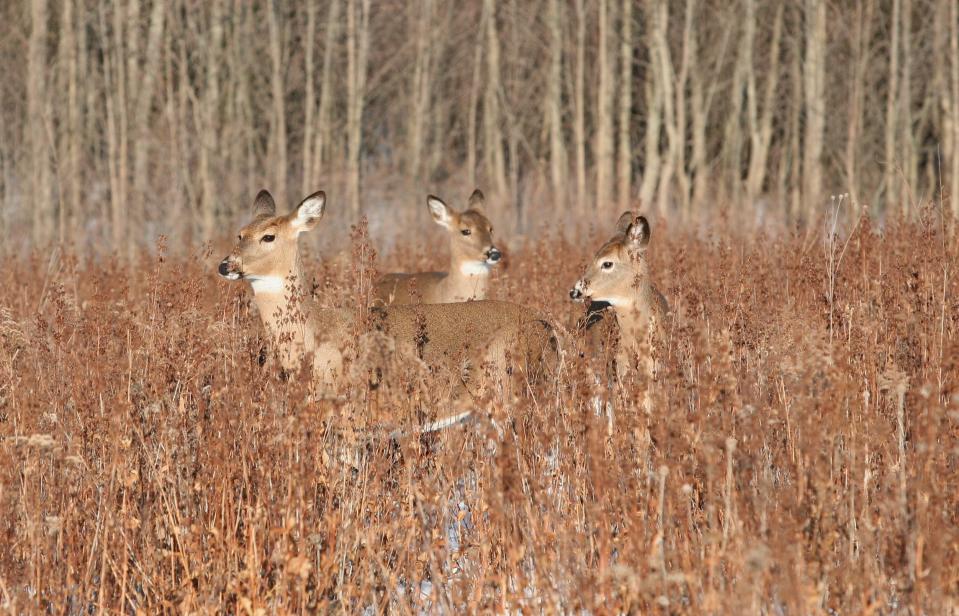Annual survey of deer hunters provides a gauge on Wisconsin wildlife

Sitting quietly in an elevated stand isn't just the predominant contemporary method for hunting white-tailed deer in Wisconsin. It's also a means for seeing other wildlife species.
In recognition of these facts, the Department of Natural Resources asks the state's more than 700,000 licensed deer hunters to submit information for the agency's annual deer hunter wildlife survey.
The work provides an additional gauge of deer and other wildlife numbers and distribution in the state, said Jeff Pritzl, DNR deer specialist.
The survey requests hunters to report the date they hunted, number of hours, a rating of the weather from 1 to 10, and the number of deer, turkey, skunk, house cat, ruffed grouse, red fox, gray fox, coyote, wolf, raccoon, porcupine, opossum, badger, bear, bobcat, fisher, elk and otter they saw while hunting.
It also contains a comment field to include information on any other wildlife not listed. Hunters are encouraged to report their activity even if no wildlife was sighted.
The 2022 survey was the 14th year of the current version of the Deer Hunter Wildlife Survey. Participants could submit observations via three methods: smartphone, desktop or mail. Eighty-seven percent of the observations were submitted via the mail, according to the DNR.
The 2022 statewide results showed 0.78 deer seen per hour hunted, the highest since the online version of the survey began in 2009.
More: Outdoors calendar
The previous deer seen per hour were 0.66 in 2021, 0.71 (2020), 0.61 (2019), 0.70 (2018), 0.72 (2017), 0.45 (2016), 0.64 (2015), 0.40 (2014), 0.43 (2013), 0.39 (2012), 0.32 (2011), 0.28 (2010) and 0.19 (2009).
The 2022 data came from a reported 5,890 hunting trips in 80 of the state's 82 deer management units (only Monroe Central Forest and Menominee County were not represented). Hunters reported spending 23,929 observation hours in the field and averaged 4.1 hours per trip.
As expected, deer seen per hour varied between deer management zones with the high being the Central Farmland Zone averaging 0.96 deer per hour and the low being the Northern Forest Zone averaging 0.50 deer per hour.
All zones except the Southern Farmland Zone saw an increase in deer seen per hour hunted from 2021.
In 2022, deer hunters reported fewer trips (5,890) than in 2021 (6,427).
Overall, hunters saw about the same number of other species per hours hunted in 2022 than 2021.
The most frequently observed species other than deer were turkeys at 0.37 per hour; ruffed grouse were next at 0.04 per hour.
Reporting rates for wildlife generally followed their perceived ranges, according to the DNR. As examples, bobcat had highest reporting in the Central Forest Zone, while otter and porcupine had highest reporting rates in the Northern Forest Zone, according to the 2022 report.
And among larger carnivores, wolves had the highest reporting rate in the Northern Forest Zone, coyotes had the highest reporting rate in the Southern Farmland Zone and most bear observations occurred in the Northern Forest Zone.
The DNR is requesting participation by hunters again during the 2023-24 deer hunting seasons.
The 2023 survey is open through Jan. 7. It requires no registration and observations can be submitted from the field with a smartphone, at home from a computer or through the mail.
For more information, visit dnr.wi.gov or contact Jes Rees Lohr, DNR research scientist, at JessicaReesLohr@wisconsin.gov
This article originally appeared on Milwaukee Journal Sentinel: Annual survey of Wisconsin deer hunters provides gauge on wildlife

